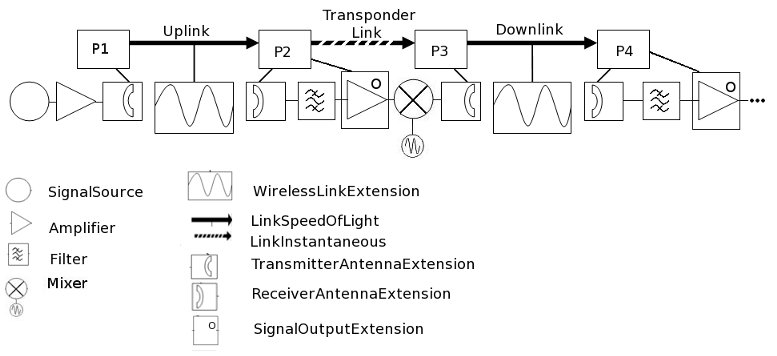Advanced Communications |
This topic describes the low level functionality of the Communications Library. At this level you may control all aspects of your communication system, building it up piece by piece. If you do not need this level of flexibility, you may want to consider using the higher level communication objects instead. The high level communication objects are built up from these low level pieces, making this advanced topic pertinent, but not necessary for creating a communication system.
The functionality described in this topic requires a license for the Communications Library. |
There are several key areas of the Communications Library.
Signals and SignalProcessors - A SignalProcessor represents an abstract process which changes the properties of a set of signals. Usually, each instance models a particular kind of electrical circuit used to process a set of signals from either a data source or a receiving antenna. Examples include amplifiers, filters, mixers, modulators, and demodulators.
Platforms and Antennas - Platforms are generalized objects which can represent the position and orientation of a given device or craft. In this case, platforms are used to represent antennas by specifying a position and orientation as well as additional models such as an antenna gain pattern.
Wireless Propagation - A link represents a connection between two platforms and provides services which can be used by constraints and figures of merit. A wireless link is distinguished by the presence of wireless propagation models, which determine how to modify signal properties as a function of the link geometry and time delay.
Link Budget and Constraints - A link budget may be constructed by using Scalar types for various values (e.g. C/No, C/I, BER). Then, it is possible to create access constraints and figures of merit based on these scalar parameters.
Advanced Communications Code Sample - An example of an end to end communication problem which demonstrates the concepts listed above and provides a good starting place for new users of Communications Library.
Phased Array Antenna Code Sample - An example of how to configure and use a phased array receiver for steering a null in the direction of jamming interference.
The following diagram shows the relationship of the various types used in a typical communications analysis problem. At a low level, the user creates each piece of the analysis and hooks it all together to create a flexible and highly extensible framework. Platforms define the geometry. Links define the time delay between nodes. WirelessLinkExtensions define how to propagate the signals through space. Signal Processors define how the signal is created, modified, reconfigured, and received. Antenna Extensions define how to transmit and receive signals from the graph of links available. Finally, the user creates scalar link budget parameters based on the pieces in this framework.
